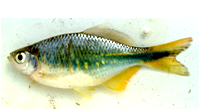The fish kept labeled as Devario under ‘Lot 7’ in the field, has usually been found frequenting along with the shoals of Danio rerio (Lot 6) [and also with the shoals of fishes characterized under Lot 8] in shallow, quiet, clear waters where there is thick growth of marginal emergent or submerged aquatic vegetation, prevalent at downstream sections of Song and Suswa of Eastern Doon and Asan, Tons and Yamuna of Western Doon.
The chief characterization of this sample is as follows:
Barbels: 1 pair, rudimentary maxillary.
Body deeper and laterally compressed with dorsal fin set far back almost opposite the anal.
Diagnostic colouration: Body silvery with sea greenish-yellow sheen; the lower half of body more bluish-green (peacock blue) with bright yellow vertical bands [originating from behind the gill opening] turning into spots [as approaching towards lower caudal base]; the area posterior to the upper edge of opercles darkly pigmented [appearing as a faint blotch]; a narrow bluish (peacock blue) iridescent band commencing about the middle of the posterior half of body , almost opposite middle of the dorsal fin or just opposite to the origin of anal fin, becoming wider at the caudal peduncular end and then continuing along middle of caudal fin, thence narrowing along the 4 fin rays of the upper caudal lobe; the bluish band is flanked dorsally by a parallelly running yellow band and similarly by a fainter one along the lower border [as if the yellow spots on the flanks coalescing towards the posterior extremity; pectoral, pelvic, anal and caudal fins yellow; both pelvic and anal edged red; the dorsal fin light grayish and edged black; the caudal also edged black.
The vertical row of scales at the end of caudal peduncle is directed obliquely upwards.
Unhesitatingly identify this Lot as: ………………..Devario devario
Devario devario (Lateral view): Body deeper and laterally compressed, with diagnostic colouration [specimen 1 and 2 collected from different locations with lighter and darker shades, respectively], silvery with sea greenish-yellow sheen. Dorsal fin set far back almost opposite the anal. The lower half of body more bluish-green (peacock blue) with bright yellow vertical bands [from behind the gill opening] turning into spots [as approaching towards lower caudal base]. A narrow bluish iridescent band commences about the middle in posterior half of body.
MORE PHOTOGRAPHS OF Devario devario
![Devario devario (Posterior half enlarged): Showing a narrow bluish (peacock blue) iridescent band commencing about the middle of posterior half of body, becoming wider at the caudal peduncular end and then continuing along middle of caudal fin, thence narrowing along the 4 lower fin rays of the upper caudal lobe. The bluish band is flanked dorsally by a parallelly running yellow band and similarly by a fainter one along the lower border [as if the yellow spots on the flanks coalescing to form a band towards the posterior extremity].](https://fishbiopedia.com/wp-content/uploads/2019/12/cVJZ7r-e1576433112716.jpg)
FAVOURITE DWELLING SITES OF Devario devario
[see also Lot 6]


- Systematic position:
Family: Cyprinidae
Subfamily: Rasborinae (= Danioninae)
- A very good ornamental fish for the home aquaria
[pl. also refer to: https://www.researchgate.net › publication
316785989_ORNAMENTAL_F… & www.mutagens.co.in › jgb › vol.06] - The nomenclatural status is followed after Fang (2003):
‘Phylogenetic Analysis of the Asian Cyprinid Genus Danio (Teleostei,
Cyprinidae). Copeia,(4):714–728.








